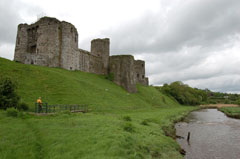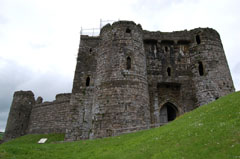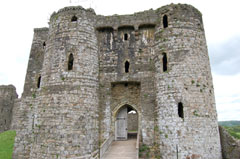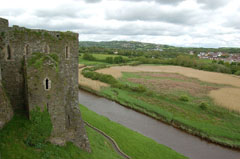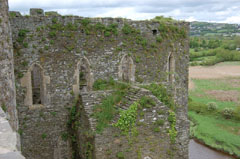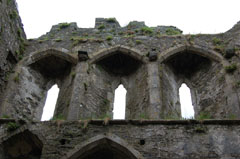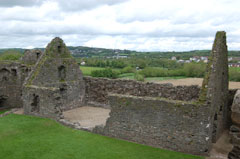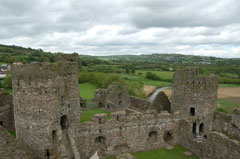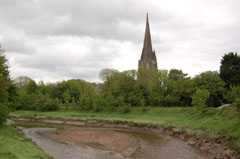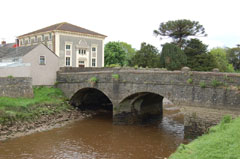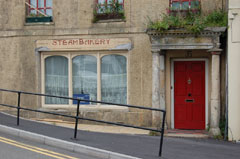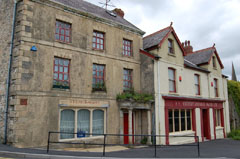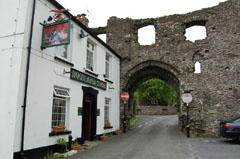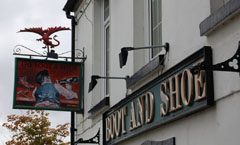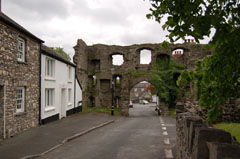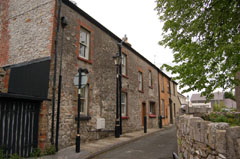Kidwelly, or Cydweli - From 'A Topographical Dictionary of Wales' (1849)
KIDWELLY, or CYDWELI, an incorporated market-town, and a parish, with separate jurisdiction, locally in the hundred of Kidwelly, in the union of Llanelly, county of Carmarthen, South Wales, 9 miles (S. by E.) from Carmarthen, and 225 (W.) from London; containing 1563 inhabitants, of whom 1297 are in the borough, and the remainder in the suburbs. This is a place of great antiquity, and by some historians is supposed to have been the scene of the battle between Ambrosius and Vortigern, which Bede states to have been fought in the year 458. According to Camden, this part of the principality was for many years occupied by the Scots under the sons of Keianus, who were finally expelled by the illustrious British prince, Cunadda. In the reign of William Rufus, William de Londres, one of the twelve knights who attended Fitz-Hamon in his successful attempt upon Glamorgan, and to whom the lordship of Ogmore, in that county, was afterwards assigned, subsequently made a conquest of this district, where he is said to have erected the castle, to which the town was indebted for the importance it attained. The erection of this fortress, however, is attributed with greater probability to one of his descendants, Maurice de Londres, who, according to Camden, after a troublesome war, made himself master of Kidwelly, and fortified the old town with walls and a castle. It afterwards became the scene of some important military events. In the year 1114, the town and fortress were surprised and taken by Grufydd ab Rhŷs, who retained possession only for a short time; and after their re-capture, Gwenllian, wife of Grufydd, a woman of masculine intrepidity, with a view to recover her husband's territories, placed herself at the head of a body of forces, and, attended by her two sons, attacked Maurice de Londres at a place in the vicinity of the castle, where she was defeated, made prisoner, and put to death by her adversary, one of her sons being also slain, and the other made captive: the place where this battle was fought is still called Maes Gwenllian, or "Gwenllian's field." In 1148, Cadell, one of the sons of Grufydd ab Rhŷs, issuing from Carmarthen with a powerful body of forces, ravaged and laid waste the country around this town. The castle was repaired and strengthened, in 1190, by Rhŷs ab Grufydd, but was subsequently demolished in 1233, by Grufydd, son of Llewelyn ab Iorwerth, Prince of North Wales, who had come into this part of the country to oppose the invasions of the Earl of Pembroke, and, hearing that a plot had been concerted by the inhabitants of Kidwelly, to betray him into the power of the English, fired the town, and marched to Carmarthen.
By the marriage of the grand-daughter of Maurice de Londres with Henry, Earl of Lancaster, the castle and lordship of Kidwelly became the property of this nobleman, and the exclusive jurisdiction at present exercised in the town and lordship owes its origin to the erection of the estates of this earldom into a county palatine in the reign of Edward III. These estates, by descent, became vested in the crown in the reign of Henry VII., who granted the castle and lordship to the celebrated Rhŷs ab Thomas, to whose assistance that monarch had been materially indebted for the success of his efforts to obtain the throne. On the attainder of Grufydd, grandson of Rhŷs, they again reverted to the crown. In the reign of Charles I. they were sold to the Vaughans of Golden Grove, in this county; and, after the death of John Vaughan, Esq., early in the present century, became the property of his devisee, Lord Cawdor, whose son and successor, Earl Cawdor, is the present proprietor. The lordship, honour, and liberty of Kidwelly comprises the comots, or hundreds, of Carnawllon, Iscennen, and Kidwelly, and contains sixteen parishes and nineteen manors. By virtue of a grant from King Charles I., the successive lords have claimed and exercised exclusive jurisdiction within the lordship, independently of the rest of the county of Carmarthen, and also various extensive and important privileges. The lord's officer holds the offices of bailiff itinerant, and bailiff of the liberties of the castles and lordship within the said liberty; and he is also coroner, escheator, and steward of the courts baron, which are held separately for each hundred. He has the return of all writs which run in the liberty, excepting only non omittas writs; and, as bailiff of the liberty, summonses, for the assizes and quartersessions, the grand and petit jurors of that part of the county which lies within its peculiar jurisdiction.
The town occupies a low and uninteresting situation on the banks of the Gwendraeth V�ch, or Lesser Gwendraeth river, which divides it into two portions, called respectively the Old and the New Town: the former of these, situated on the western side, is connected with the latter by a handsome stone bridge. The prosperity of this once important place seems to have been completely annihilated by destructive fires and other misfortunes, prior to the reign of Queen Elizabeth, when its inhabitants were at the lowest ebb of poverty, as appears by a memorial drawn up on their behalf by a native of the town, and presented to Sir George Carew, Knight Marshal. The Old Town was formerly surrounded with walls, having three gates, over one of which, in Leland's time, were the remains of a town-hall, with a prison underneath. It now consists, with few exceptions, merely of hovels; and the New Town contains very few respectable dwelling-houses, the majority being thatched cottages of inferior appearance. The air is salubrious, and the place is considered very healthy.
The advantages which it derived from its situation on a navigable river, within half a mile of its influx into the great bay of Carmarthen, having ceased, from the obstruction of the navigation with sand, which formed a dangerous bar across the mouth of the river, its commerce, once flourishing, in consequence declined; and latterly, the opening of collieries, and the establishment of copper-works, at Llanelly, to which this port is a creek, transferred nearly all the remaining trade of Kidwelly to that place. Many fruitless attempts were made to improve the navigation of the river, and various sums were expended in unavailing efforts to remove the obstructions that impeded it; the sands, however, which formerly accumulated, have now totally disappeared through the operations of nature. Some docks, and a short canal, were constructed here about the year 1766, by Mr. Keymer, a private individual; the docks are situated about half a mile from the town, and the canal was intended to convey coal from the mouth of the neighbouring pits to the vessels in the harbour. This navigation was some time since transferred to a company, known as the "Kidwelly Canal Company," by whom it was extended a distance of two miles up the Vale of Gwendraeth, and a branch three miles and a half in length was constructed to communicate with Penbrey harbour: it now extends for fifteen miles. The South Wales railway will run by Kidwelly. Here were both iron and tin works; the former have been entirely abandoned, and the latter are now conducted only on a very limited scale. The exports are, coal to the opposite side of the Bristol Channel, and corn, cheese, and other agricultural produce to Bristol. Markets were held by charter, on Tuesday and Friday; but that on Tuesday has been discontinued, and the other, from the proximity of Carmarthen and Llanelly, has become merely a market for butchers' meat and vegetables. Fairs are held on August 3rd and October 29th.
There are five charters in the possession of the corporation, of which the four first, dated, respectively, the 30th of Edward III., 22nd of Henry VI., 32nd of Henry VIII., and 4th of Edward VI., are under the seal of the duchy of Lancaster, within which the borough is comprised. The fifth was granted by James I., under the great seal, in the sixteenth year of his reign, August 7th, 1618, and, having re-constituted the borough, is the present governing charter. The style of the corporation is, "the Mayor, Aldermen, Bailiffs, and Burgesses of the borough of Kidwelly, in the county of Carmarthen;" and the government is vested in a mayor, twelve aldermen, two bailiffs, twelve principal burgesses, a recorder, deputy-recorder, town-clerk, chamberlain, two serjeants-at-mace, and an indefinite number of burgesses. Of these officers, the mayor, who is chief magistrate, coroner, and clerk-of-themarkets, is appointed by the common-council, which consists of the mayor, aldermen, bailiffs, and principal burgesses, and is the governing body of the corporation, from among the aldermen, on the Monday next after Michaelmas-day, the charter day. The aldermen, of whom one is a magistrate, are chosen for life, and the bailiffs, who are also sheriffs, for a year, by the common-council, from the body of principal burgesses: the principal burgesses are elected for life by the council, from the burgesses. The recorder, who is a justice of the peace, the town-clerk, and the chamberlain, are also appointed by the council, during pleasure; and the serjeants-at-mace are chosen from the burgesses by the mayor.
The freedom is acquired by birth, limited, however, to the eldest sons of freemen, born after their fathers' admission. It is also to be obtained by election of the common-council, who may choose burgesses to whatever extent they please; in practice, one person is generally nominated by the mayor every year, and thereupon elected by the council. The privileges of the burgesses include exemption from serving on all county juries, and the right of grazing five head of cattle and thirty head of sheep each upon the uninclosed lands that belong to the corporation; these lands are stated to comprise about 730 acres, and are supposed to contain valuable beds of copper-ore, to which the corporation lays claim. General sessions are directed by the charter to be held before the mayor, the recorder, or, in his absence, the deputy-recorder, and the alderman who should be elected a justice as before mentioned, or any two of them, including the mayor, for the trial of all offences within the borough short of felony; and the charter declares that no other justice of the peace shall interfere with the concerns of the borough. Quarter-sessions are regularly held, and cases of misdemeanor are occasionally tried, before a jury selected by the bailiffs from among the burgesses; but it most frequently happens that there are no cases for trial. A court of record is also directed by the charter to be held within the borough before the mayor and recorder, or their sufficient deputy, every Monday fortnight, for the trial of all actions, real, personal, and mixed, under �200 in amount; and the hundred court of Kidwelly may also by the same authority take place before the mayor and steward every three weeks; but both these courts have entirely fallen into disuse, though some proceedings appear to have occurred in the former within the present century. The revenues of the corporation consist of about fifty acres of inclosed land, let upon long leases to a large number of tenants; a further inclosure of twenty acres, lately made; a considerable number of chief rents of small amount; and rent derived from a lease of certain copper-mines under the uninclosed lands: the whole producing a net income of about �120. The town-hall is a tenement possessing no features worthy of notice, which has been fitted up for the purpose.
The parish of Kidwelly is divided into St. Mary's within, and St. Mary's without the borough, each division separately maintaining its own poor. The living is a discharged vicarage, rated in the king's books at �7. 10., and in the patronage of the Lord Chancellor; present net income, �120: the impropriation belongs to the Maliphant family. The church, dedicated to St. Mary, and situated in the New Town, is an ancient cruciform structure, with a square embattled tower at the western end, surmounted by a very lofty spire; over the entrance is a figure of the Virgin, and in the interior is a monumental effigy of a priest, with an inscription now illegible. An ancient tombstone was dug up on the north side of the church, in 1846; it bears the figure of a female head, judging from the head-dress, with an inscription which is much defaced. There are places of worship for Calvinistic Methodists, Independents, Wesleyans, and Particular Baptists; a National school, chiefly supported by voluntary contributions; and six Sunday schools, one of them in connexion with the Established Church. A rentcharge of 6s. 8d., assigned by Howell Thomas in 1666, is distributed in bread among the poor annually; another of 10s. has been lost. At Penallt, near this place, was anciently a small priory of Benedictine monks, founded about the year 1130, by Roger, Bishop of Sarum, who dedicated it to St. Mary, and made it a cell to the abbey of Sherborne in Dorsetshire; it continued to flourish till the Dissolution, at which time its revenue was �38: the present remains are very inconsiderable.
Leland, speaking of the castle, in the reign of Henry VIII., states that it was then "meately wel kept up," "veri fair, and doble waullid;" having been repaired by Alice de Londres, wife of one of the Dukes of Lancaster, and again in the reign of Henry VII. The remains of this edifice occupy a bold rocky eminence on the western side of the Gwendraeth V�ch, and are more perfect than any other of a similar character in the principality. Their appearance is grand and imposing, the ruins comprising a quadrangular area, inclosed by strong walls defended with massive circular towers at the angles, and also with bastions in the intervals; the principal entrance, which is on the west side, is under a magnificent gateway, flanked by two round towers, and is still in good preservation. Many of the state apartments are almost entire, and the groined ceilings of some of them, together with other portions of the edifice, display interesting features of the early style of English architecture. A signet-ring, supposed to be of the early part of the fourteenth century, was found near the castle some years ago. |


